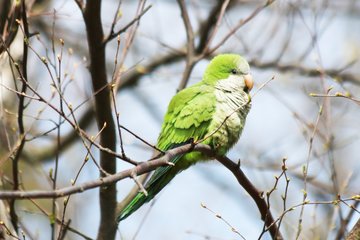City birds shy away from risk
Caution helps animals in their dealings with humans
New research suggests animals can thrive in human-dominated environments by being expert judges of risk. Alexis Breen from the Max Planck Institute for Evolutionary Anthropology in Leipzig, and Dominik Deffner from the Max Planck Institute for Human Development in Berlin, examined the behaviour of great-tailed grackles, a bird species successfully invading much of urban North America, showing the sex that leads this charge—the dispersing males—shy away from risk, which is a characteristic the researchers show is well-suited to chaotic environments like cities. These findings provide unique insight into how and why animals and humans can coexist.

For great-tailed grackles, living alongside humans is ‘risky business’, because to them cities are chaotic: they may have more cafes where animals like grackles can nab food, but they’re also filled with unpredictable people and their pets. To help manage this uncertainty, grackles might use a specific strategy when trying to find food.
The research is based on new analyses of grackles’ feeding behaviour. Across three different populations, the researchers first examined how quickly grackles learned food was hidden in one particular place over another. Next, when the location of the food was swapped, the researchers examined how quickly the grackles relearned where to find it.
Better safe than sorry

“Our key behavioural finding is that—across all three populations—male grackles were faster than female grackles at relearning the location of an out-of-sight treat. This robust result means male grackles are more efficient foragers in uncertain environments,” said Breen.
Under uncertainty, how do male grackles ‘outlearn’ female grackles? “Unlike females, males exhibit pronounced risk-sensitive learning. That is, males pay close attention to whether they recently found food, and, if so, they pretty much stick to feeding from that location, instead of gambling on exploring another location,” explained Deffner. The researchers said they were able to infer this strategy from grackles’ feeding behaviour via cognitive modelling.
“This sex differences in grackles’ learning makes biological sense,” said Breen, adding: “In this species, males are the ones that disperse and move into new territories; in other words, they lead their species’ urban invasion. So, as urban-invasion leaders, male grackles should proceed with caution—new neighbourhoods will pose new challenges”. The authors said they thought later-arriving females could overcome these same challenges by learning from the already established, and therefore presumably ‘knowledgeable’, males.
Risk-sensitive learners unpredictable environments

On their computers, the researchers also artificially simulated evolution, to examine the kinds of learning strategies that emerge victorious from unpredictable environments like urban environments. Deffner explained: “In this urban-like environment, pretend animals need to learn to find food. The learning strategy they use to find food determines how much they get to eat. And how much they get to eat determines whether they can have babies who also learn roughly the same way. Over many generations, then, the animals with the best learning strategy will come to dominate the urban-like environment. Importantly, these ‘winners’ will give us an idea of how animals in general can thrive in the Anthropocene”.
Which learning strategy do unpredictable urban-like environments prefer? “Strikingly, in times of uncertainty, we found risk-sensitive learners were more likely to dominate over learners with other strategies. This result implies risk-sensitive learners like male grackles are better adapted to cope in chaotic settings, human-induced or otherwise”, said Breen.
Breen concluded: “Our study offers compelling evidence for how and why at least grackles are thriving in unpredictable urban environments. We link sex differences in foraging grackles’ learning strategies to sex differences in who leads their species’ invasion, and we further link the learning strategy used by these urban-invasion leaders to likely being a generally good one for any animal navigating a life shared with humans”.
To help facilitate future similar study on human-animal coexistence, the researchers created an online repository where scientists and the public alike can freely access their custom-built modelling tools. In reference to the repository, Deffner said: “We hope this open-science resource proves useful to others”.














